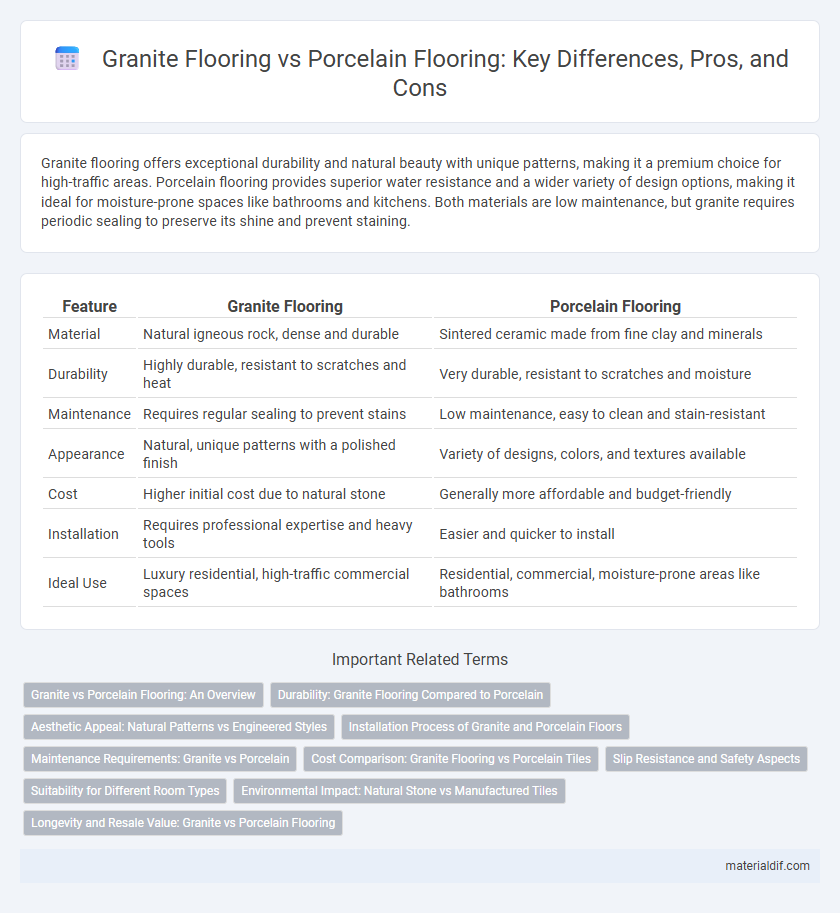Granite flooring offers exceptional durability and natural beauty with unique patterns, making it a premium choice for high-traffic areas. Porcelain flooring provides superior water resistance and a wider variety of design options, making it ideal for moisture-prone spaces like bathrooms and kitchens. Both materials are low maintenance, but granite requires periodic sealing to preserve its shine and prevent staining.
Table of Comparison
| Feature | Granite Flooring | Porcelain Flooring |
|---|---|---|
| Material | Natural igneous rock, dense and durable | Sintered ceramic made from fine clay and minerals |
| Durability | Highly durable, resistant to scratches and heat | Very durable, resistant to scratches and moisture |
| Maintenance | Requires regular sealing to prevent stains | Low maintenance, easy to clean and stain-resistant |
| Appearance | Natural, unique patterns with a polished finish | Variety of designs, colors, and textures available |
| Cost | Higher initial cost due to natural stone | Generally more affordable and budget-friendly |
| Installation | Requires professional expertise and heavy tools | Easier and quicker to install |
| Ideal Use | Luxury residential, high-traffic commercial spaces | Residential, commercial, moisture-prone areas like bathrooms |
Granite vs Porcelain Flooring: An Overview
Granite flooring offers natural stone durability and unique patterns, making it highly resistant to scratches and heat compared to porcelain flooring, which provides a more uniform appearance and greater moisture resistance. Porcelain tiles are generally more affordable and easier to maintain, ideal for areas prone to moisture like bathrooms and kitchens, while granite is favored for its premium aesthetic and long-term value in high-traffic spaces. Both materials excel in hardness and stain resistance, but granite's natural origin contributes to its distinctive look, contrasting with porcelain's versatility in design and texture options.
Durability: Granite Flooring Compared to Porcelain
Granite flooring offers superior durability due to its natural formation from volcanic activity, making it highly resistant to scratches, heat, and heavy foot traffic. Porcelain flooring, though strong and less porous, is more susceptible to chipping and cracking under extreme impacts compared to the dense crystalline structure of granite. For long-term resilience in high-traffic areas, granite flooring consistently outperforms porcelain in maintaining structural integrity and surface quality.
Aesthetic Appeal: Natural Patterns vs Engineered Styles
Granite flooring showcases unique, natural patterns formed by the crystallization of minerals, offering a one-of-a-kind aesthetic with rich textures and color variations that enhance any interior space. Porcelain flooring features engineered styles, allowing precise replication of various designs, including wood and stone looks, with consistent patterns and a sleek, uniform finish. The choice between granite's organic beauty and porcelain's versatile styling depends on desired visual impact and maintenance preferences.
Installation Process of Granite and Porcelain Floors
Granite flooring installation involves cutting and fitting heavy slabs precisely, followed by securing them with a high-strength adhesive and grout to ensure durability and stability. Porcelain flooring requires careful subfloor preparation, precise tile placement, and consistent use of thin-set mortar and grout, with less effort in handling due to its lighter weight and uniform size. Both materials demand skilled labor and proper tools to achieve seamless finishes, but granite's installation is generally more labor-intensive and time-consuming due to its density and weight.
Maintenance Requirements: Granite vs Porcelain
Granite flooring demands regular sealing to maintain its natural stone's durability and resistance to stains, while porcelain tiles require minimal maintenance with simple cleaning to prevent dirt buildup. Both materials are highly resistant to scratches, but granite's porous nature calls for occasional resealing to protect against moisture penetration and potential staining. Porcelain flooring offers a low-maintenance alternative with its non-porous surface, making it ideal for high-traffic and moisture-prone areas without the need for frequent treatments.
Cost Comparison: Granite Flooring vs Porcelain Tiles
Granite flooring typically costs between $40 and $100 per square foot, including installation, due to its natural stone extraction and processing expenses. Porcelain tiles range from $5 to $30 per square foot, offering a more affordable option while maintaining durability and resistance to moisture. While granite commands a higher initial investment, porcelain flooring provides cost-effective versatility suitable for budget-conscious projects.
Slip Resistance and Safety Aspects
Granite flooring offers high slip resistance due to its natural textured surface, making it a safer option in wet areas compared to porcelain flooring, which can be more slippery unless treated with anti-slip coatings. The durability and hardness of granite also contribute to its ability to maintain traction over time, reducing the risk of falls. Porcelain tiles may require additional surface treatments or textured finishes to achieve similar safety standards in flooring applications.
Suitability for Different Room Types
Granite flooring is highly suitable for high-traffic areas such as kitchens and hallways due to its exceptional durability and resistance to scratches and stains. Porcelain flooring works well in bathrooms and laundry rooms because of its superior water resistance and slip-resistant surface options. Both materials offer excellent longevity, but room-specific moisture levels and wear patterns should guide the selection for optimal performance.
Environmental Impact: Natural Stone vs Manufactured Tiles
Granite flooring, sourced from natural stone, offers a lower environmental impact due to its durability and minimal processing compared to porcelain tiles, which require significant energy consumption during manufacturing. The quarrying process for granite involves less chemical use and generates fewer emissions, whereas porcelain production relies on high-temperature kilns running on non-renewable energy sources. Granite's long lifespan and recyclability reduce waste, making it a more sustainable flooring option compared to manufactured porcelain tiles.
Longevity and Resale Value: Granite vs Porcelain Flooring
Granite flooring offers exceptional longevity due to its natural hardness and resistance to scratches, often lasting over 50 years with proper care. Porcelain flooring provides strong durability and is less porous, reducing maintenance needs while maintaining appearance for decades. In terms of resale value, granite typically commands a higher premium because its natural stone appeal is perceived as more luxurious and timeless compared to porcelain alternatives.
Granite Flooring vs Porcelain Flooring Infographic

 materialdif.com
materialdif.com